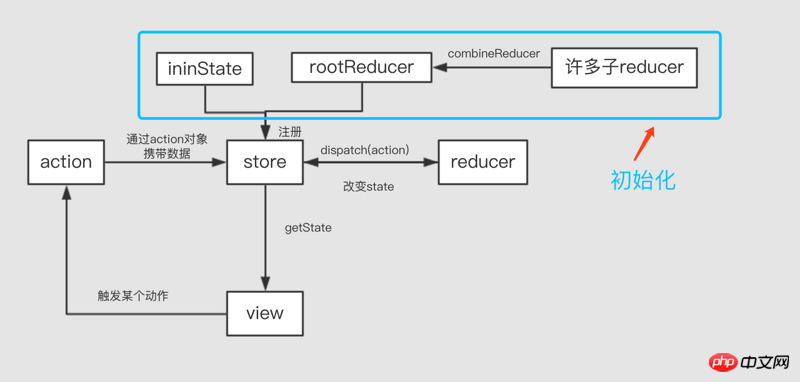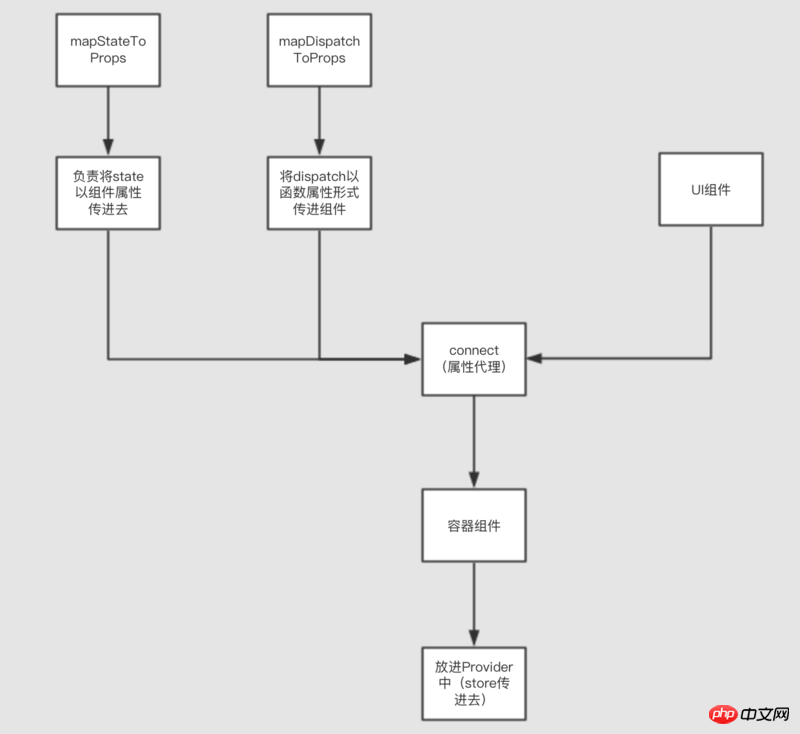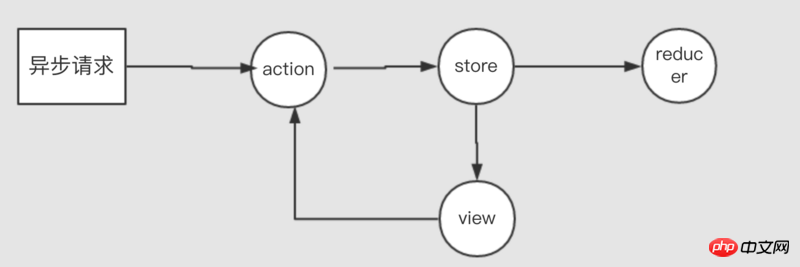這次帶給大家使用react redux中間件步驟詳解,使用react redux中間件的注意事項有哪些,下面就是實戰案例,一起來看一下。
用過react的同學都知道在redux的存在,redux就是一種前端用來儲存資料的倉庫,並對改倉庫進行增刪改查操作的一種框架,它不僅適用於react ,也使用於其他前端框架。研究過redux原始碼的人都覺得該原始碼很精妙,而本博文就針對redux中對中間件的處理進行介紹。
在講redux中間件之前,先用兩張圖來大致介紹一下redux的基本原理:

圖中就是redux的基本流程,這裡就不細說。
一般在react中不只利用redux,還利用到react-redux:

react-redux這裡也不細說。
redux中間件
一般情況下,redux是不具備處理非同步請求的能力,稚嫩溝通過間接或者添加中間件的方式,加強了對dispatch的能力,是的redux具備非同步的能力;
一般來說,redux處理非同步的方式有兩種:間接方式和中間件方式;
間接方式:
間接方式就死自訂非同步的行為,保留dispatch同步的功能。
思路:就是講異步回傳的結果塞進action中,然後在透過dispatch同步到reduce中,再改變state;

request.get(API)
.then(d => {
store.dispatch(type: xxx, playload: d)
})中間件方式
中間件方式中核心部分就是redux提供的applyMiddleWare這個高階函數,它透過多層呼叫後悔回傳一個全新的store物件,全新的store物件和原來物件中,唯一的不同就是dispatch具備了非同步的功能;
原始碼:const applyMiddleWare = (...middlewares) => createStore => (reducer, initState) =>{
const store = createStore(reducer, initState);
const _dispatch = store.dispatch;
const MiddleWareAPI = {
getState: store.getState,
dispatch: action => _dispatch(action) 1)
};
const chain = [];
chain = middlewares.map(middleware => {middleware(MiddleWareAPI)}); 2)
let dispatch = compose(...chain)(store.dispatch); 3)
return {
dispatch,
...store
}
}陣列從右到左一次地櫃注入到前一個中間件,而store.dispatch會注入到最右邊的一個的中間件。其實這裡可以將compose理解為reduce函數。
eg:M = [M1,M2,M3] ----> M1(M2(M3(store.dispatch)));
const MiddleWare = store => next => action => {
...
}区别:
next(最右边的中间件):其实是真正触发reducer,改变state的dispatch,这里的dispatch和state是同步关系的;这里的action必须是一个对象,不能含有异步信息;
next(非最右边的中间件):其实就是相邻前一个中间件返回的函数(action => {...});这里的action就是上一级中间件next(action)中的action,第一个中间件的action就是项目中store.dispatch(action)中的action。
中间件中的store.dispatch:其实就是用来塞进action的,这里就理解为action和中间件通信的渠道吧。
流程图:

demo:
export const MiddleForTest = store => next => action => {
if (typeof action === 'function') {
action(store);
} else {
next(action);
}
};
export const MiddleForTestTwo = store => next => action => {
next(action);
};
export function AjaxAction(store) {
setTimeout(function () {
store.dispatch({
type: 'up',
playload: '异步信息'
})
}, 1000)
}
store.dispatch(AjaxAction);说道这里应该会对中间件有个大致的认识,接下来介绍一下常用的中间件以及自己写一个中间件。
redux-thunk:主要是适用于action是一个函数的情况,它是对原有的中间件模式再封装多一层,原则上是支持promise为主的action函数;
export function AjaxThunk (url, type) {
return dispatch => {
Ajax(url)
.then(d => {
dispatch({
type,
playload: d
})
})
}
}
store.dispatch(AjaxThunk(url1, 'add'));redux-promise:主要就是针对action对象,action对象是一个promise的异步请求函数:
它的大概实现思路是:
const promiseAction = store => next => action => {
const {type, playload} = action;
if (playload && typeof playload.then === 'function') {
playload.then(result => {
store.dispatch({type, playload: result});
}).catch(e => {})
} else {
next(action);
}
}
action = {
type: 'xxx',
playload: Ajax(url)
}自定义中间件:很多时候网上的redux中间件可能不太符合项目中的需要,所以这时候可以自己写一套适合项目的中间件,以下指示本博主的一个demo,形式不唯一:
export const PromiseWares = store => next => action => {
next({type: 'right', playload: 'loading'});
if (typeof action === 'function') {
const {dispatch} = store;
action(dispatch);
} else {
const {type, playload} = action;
if (playload && typeof playload.then === 'function') {
playload.then(result => {
store.dispatch({type, playload: result});
}).catch(e => {})
} else {
next(action);
next({type: 'right', playload: 'noLoading'});
}
}
};相信看了本文案例你已经掌握了方法,更多精彩请关注php中文网其它相关文章!
推荐阅读:
以上是使用react redux中介軟體步驟詳解的詳細內容。更多資訊請關注PHP中文網其他相關文章!




